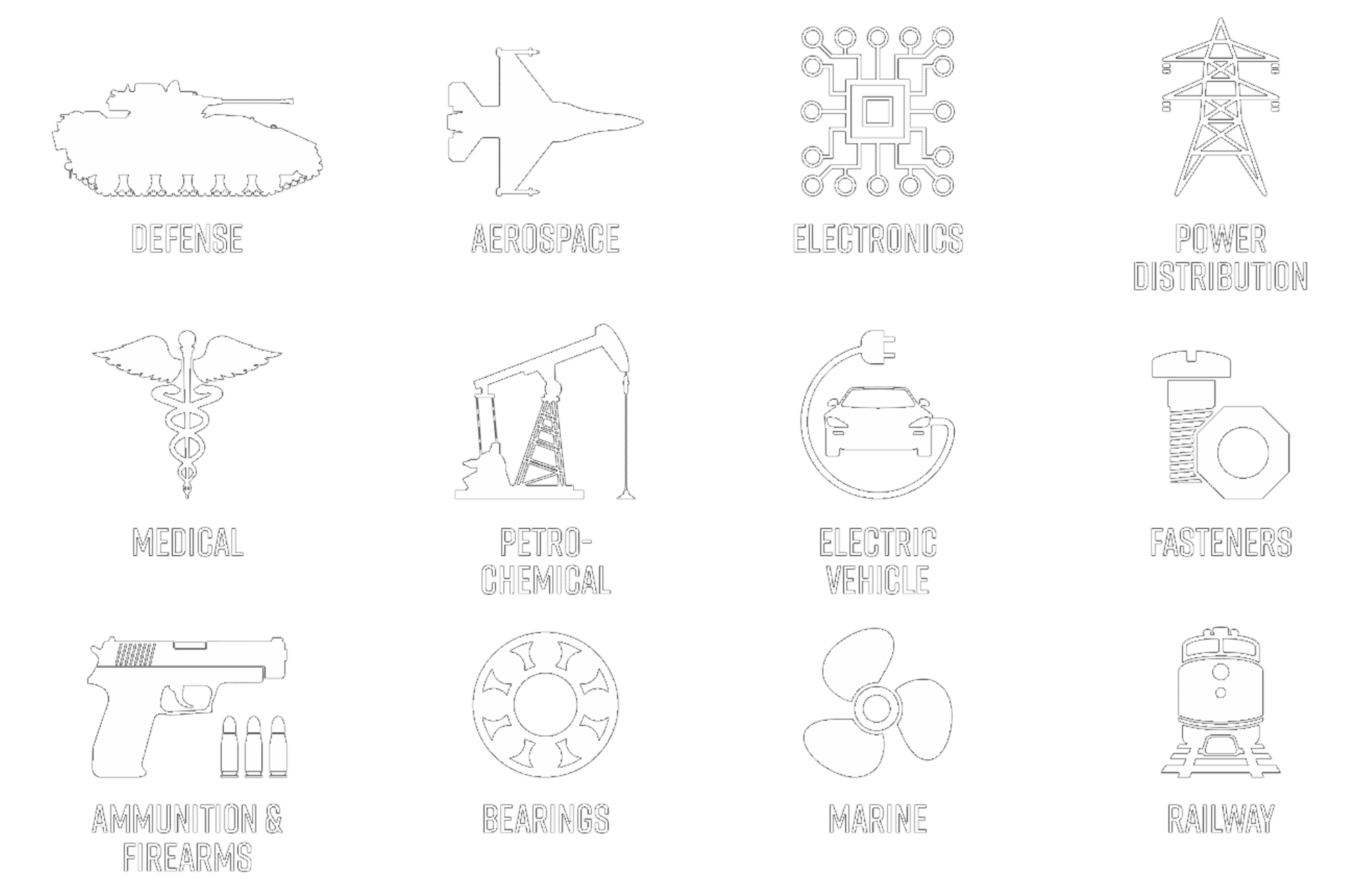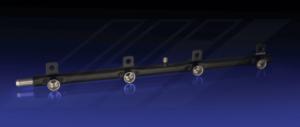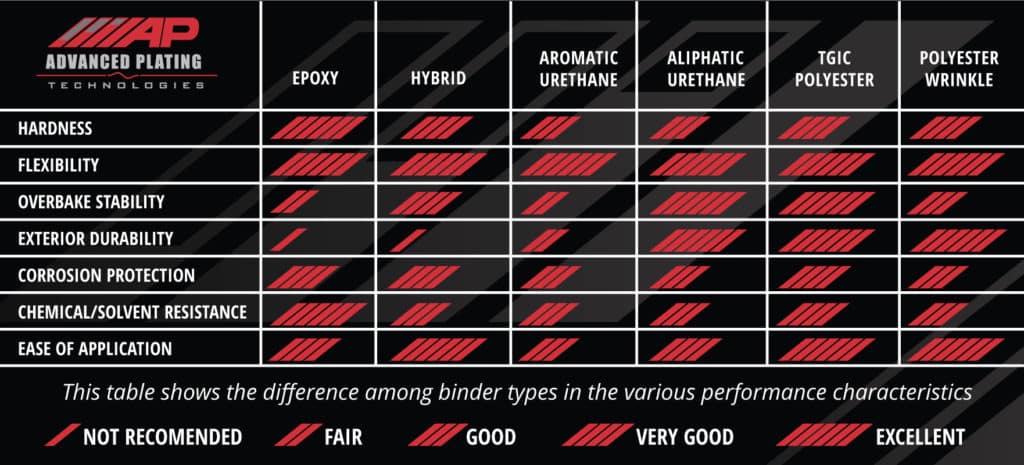Protection of metal fabricated components is critical to the long-term durability of the final product. Surface finishing through powder coating or wet painting are both common solutions to protect various components. Both powder coating and wet paint systems contain similar resins, additives, and pigments; however, there are marked differences between these two painting systems. Most notably, wet paint systems require the use of solvents to suspend the mixture in the fluid form.
Powder coating is applied as a dry powder without solvents, however, the powder paint must be baked or cured on the surface of the part. This primary difference in application method results in several advantages and disadvantages between these two coating options.
Powder Coating Background
How Does Powder Coating Work?
Powder coating is performed by emitting dry powder paint via compressed air through an electrostatic gun onto the exterior of the coated part. The electrostatic gun provides the powder with a negative charge, and the negatively charged powder is attracted to the grounded metal components.
The attraction between the powder and the components as well as the dry application method allows for a heavier paint thickness ranging between 0.002-0.006 inches per side. Since powder coat systems are applied in the dry state there is no need for a solvent to carry the resins and pigments to the surface.
After the powder is applied it is cured on the part by baking. Typical cure cycles range from 300-400F and from 10-30 minutes. During the curing the solid powder particles melt to form a liquid that is held to the surface through surface tension.
The melted powder cross-links and cures to again form a solid. The paint first solidifies on the outermost surface forming a solid skin and eventually cures throughout the entire layer. After the baking cycle the paint is fully cured and parts can be immediately handled upon cooling.
Types of Resins Used in Powder Coating
Like wet spray paint, various resin systems are available including epoxy, urethane, polyester and hybrid (mixed) resins. Each resin system has pros and cons in various properties including UV stability, hardness, flexibility, corrosion protection, chemical stability. Some powders are very easy to apply with excellent flow properties that result in a smooth finish, whereas other powders with reduced flow are more prone to a visible texture or orange peel.
Both urethane and polyester powder coating are recommended for external applications due to their UV-resistant properties. Chalking is prevalent in epoxy-based powder systems when repeatedly exposed to UV light. Chalking is the deterioration of the coating from extended UV exposure. The initial signs of chalking are faded color, which will progress to complete deterioration of the coating.
Figure 1 summarizes some of the other properties of the various powder coating resin systems. Most commonly epoxy and hybrid (polyester/epoxy blends) are used in applications where chemical resistance is most critical and UV stability is not needed. Urethane coatings offer excellent flexibility and UV stability but do not have the hardness and chemical resistance of epoxy or polyester systems. The best all around resin system is a polyester as they provide UV stability with good corrosion resistance and hardness.
Advantages of Powder Coating Over Wet Spray Painting
– Environmentally Friendly: 
– Durability: Powder coat is typically 3-6 times thicker than wet spray paint. The higher thickness improves the corrosion resistance and overall durability verses wet spray paint. In addition, the thermal bonding process of powder paint provides a stronger bond and structure of the paint making less prone to chipping.
– Life Cycle Cost: Although the initial application costs of powder coating may be higher than wet spray paint, the improved durability and corrosion protection of powder coat paint often result in a longer life of the product as such this can help reduce the overall coating cost per year of product service.
– Safety: The solvent carriers used in wet spray paints are a health risk as well as well as highly flammable. Build-up of wet paints within spray booths pose a significant fire risk as do the storage of wet paints. Inhalation of solvents can lead to irritation of the nose and lungs and can lead to various VOC related health issues.
Wet Spray Paint Background
Application
Liquid paint is applied in a fine spray, in which the resin of the paint is suspended within a solvent or carrier. The solvents used are Volatile Organic Compounds (VOCs) such as methyl ethyl ketone (MEK), turpentine, methylated spirits (mixture of methanol and ethanol), xylene, toluene and acetone. The paint is held on the surface of the part through surface tension making it very prone to drips and sags if applied too heavily.
The solvent then evaporates from the surface of the part resulting in a cured painted surface. This process can be accelerated through baking of the parts and multiple coatings of paint are often applied to increase overall thickness. Commonly, wet spray paints are applied between 0.0005-0.001 inches per side.
Advantages of Wet Spray Painting Over Powder Coating:
– Self-Drying: An oven is not required for spray-painted parts. Powder coated parts require an oven for the cure process
– Color Matching and Touch-Up: Color alterations are easily adjusted with wet paint systems. Wet paints are readily mixed on site to achieve the desired final product. In addition, wet spray paint systems are very easily reapplied to the surface for touch-up or repairs as required.
– Thickness (thin): Wet paint can be applied to a surface with minimal thickness and still achieve a smooth coat. Although thinner coatings provide less durability, they are preferred in some applications where part tolerances, fitment or a mirror-like smooth finish are important.
– Expense: The cost of getting a component coated via sprayed paint for example is generally lower than powder coating. In addition, parts can be reworked or painted multiple times with wet spray systems much more easily than with powder coating.
– Range of Substrates: Because wet spray paints do not require electrostatic attraction to be applied nor do they require baking to cure, they can be readily applied to any substrate including non-metallic parts such as fiberglass, plastics and wood. Powder coating requires the component to be electrically conductive such that the negatively charged particles are attracted to the grounded part. Although specialized processes exist for powder coating nonmetallic components, they are not readily available.
Comparing Powder Coating vs Wet Spray Painting

Both powder coating and wet spray paint systems use similar resins including epoxy, polyester and urethanes. Powder coating results in a coating 3-5 times thicker which offers superior durability and achieve a longer lifetime than wet paint systems. Powder coating provides a more effective corrosion barrier that in turn protects the base substrate from the surrounding environment.
The durability of powder coat finishes reduces the likelihood of chips, flakes, or chalking. The powder coating price will initially exceed the cost of a wet paint system; however, powder coated finishes achieve a longer life than a wet paint system which will more than cover the difference in initial expense which can make it more cost effective.
Wet spray paint offer advantages for both color matching and touch-up painting since the part does not need to be baked to cure the paint. Unlike wet paint applications, powder colors cannot be simply mixed to make a different color, if two different powder coat colors are mixed the final finish will be a speckled combination of the two.
Although the thinner coating of wet spray paint offers reduced durability, it may be preferred for parts or applications where coating buildup must be minimized or an extremely smooth finish is required. Finally, wet spray paint can be readily applied to nearly any substrate including nonmetallic parts made from plastic or wood.
Powder Coating at Advanced Plating
History
Advanced Plating Technologies was one of the pioneering companies to offer powder coating services in Milwaukee, Wisconsin when the original powder coating system was installed in 1982. Today, Advanced Plating Technologies is a premier provider of industrial powder coating services offering a diverse selection of resin systems, textures and colors.
In addition, APT can simplify your supply chain offering both powder coating and plating services and can provide powder coat over a wide range of plated finishes. Advanced Plating Technologies offers industrial powder coating services within various industries including the medical, defense, marine, power distribution, agricultural and food processing industries.
Selective Powder Coating Capabilities
Powder coating offers key advantages over competing painting processes such as e-coat or wet spray paint including improved corrosion resistance and durability. However, the thickness of the powder typically ranges between 2 to 6 mils (0.002-0.006 inches). As such, functional surfaces of coated parts must often be masked including sliding wear surfaces, interference fit and threaded features, sealing surfaces, and conductive surfaces.
APT has an extensive background in selective powder coating techniques and is up to the challenge of the most demanding or selective paint requirements. Over 80% of APT’s powder coating jobs require some sort of selective coating, with some applications having upwards of thirty masks per part. APT has a dedicated engineering department that can pull from over forty years of selective experience to develop custom masks and a selective process matched to your specific application.
Contact APT for Your Specific Powder Coating Project
Advanced Plating Technologies an ISO 9001:2015 & 13485:2016 certified powder coating company that offers a full range of powder coating services for any application such as epoxy powder coating and polyester powder coating. Reverse engineering of existing or failed applications and components is available to provide design assistance. Feel free to contact a member of APT’s technical sales team for further assistance at [email protected] or 414.271.8138.
Blog Authored by Justin Koch, Manufacturing & Process Engineer









